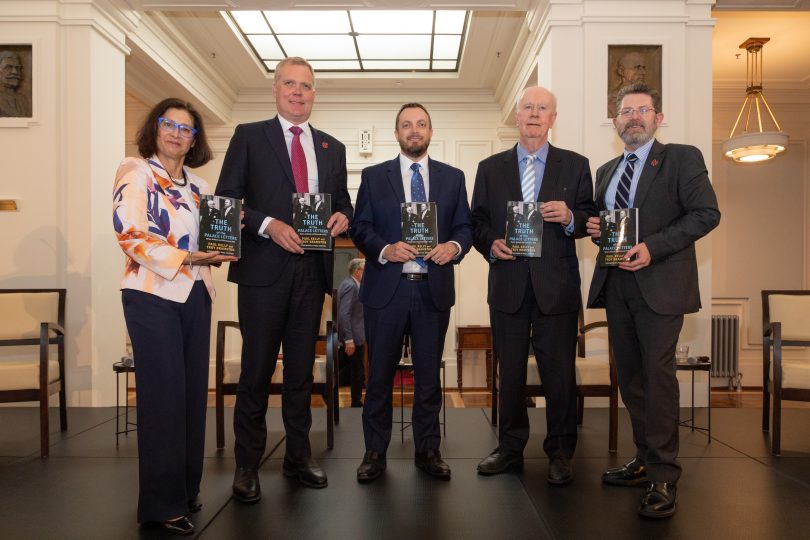
Prime Minister Gough Whitlam on the day of the dismissal. Photo: File.
Back in the early ’70s, junior journalist Paul Kelly had a favourite position between the two chambers in what’s now Old Parliament House. Top left-hand corner, beneath the pillars in Kings Hall.
He’d linger there, hoping to pick up news about the roiling constitutional crisis that was devouring the Whitlam Government as ever-more frantic messengers scurried back and forth through the rabbit warren of tiny rooms and the crowded press gallery.
And on November 11, 1975 the biggest story of his life dropped into his lap: Governor General Sir John Kerr had, with the assistance of Opposition leader Malcolm Fraser, sacked the Prime Minister.

Observers watch the launch of The Truth About the Palace Letters. Photo: Michelle Kroll
“Forty-five years ago to this day, to this lunchtime, I was standing over there as I often stood, hoping to be the recipient of some useful political information,” he said at the Remembrance Day launch of The Truth of the Palace Letters, co-authored with Troy Bramston and held at the Museum of Australian Democracy.
“The news went through me like an electric shock. We all knew dismissal was an option but somehow we didn’t take it seriously.
“I spoke to Gough all the way through the constitutional crisis and Gough’s constant refrain was ‘Comrade, I know the Governor-General will do the right thing, he’s an honourable man’.
“Everyone was in shock just after 2:00 pm that afternoon. Well, not everyone. Not Malcolm Fraser.”
Earlier this year, historian Jenny Hocking won her 10-year battle with the National Archives to reveal the contents of the letters between Kerr and the Queen’s private secretary, Sir Martin Charteris.
Aside from the rights and wrongs, there’s always been a hovering question about the Dismissal. Did the Queen know? Did she give her assent, either directly or indirectly? Was one of the darkest moments in our post-war political history directed from Buckingham Palace (let alone by the CIA)?

Troy Bramston at the launch of The Truth of the Palace Letters. Photo: Michelle Kroll.
The book argues that while the Palace Letters shed fascinating light on the personalities and give contextual information about the events of 1975, it’s abundantly clear that Her Majesty the Queen was not involved and that Palace staff urged caution about the use of the reserve powers.
Kelly and Bramston say that rather than an international conspiracy this was a wholly local episode, a vice-regal conspiracy erupting from the clash of titanic political personalities. There’s no smoking gun and there never was.
Bramston, who was born six weeks after the Dismissal, has made unearthing its history an obsession.
“I read every book, I scrolled through newspaper articles on microfiche, I watched the TV coverage, I was absorbed by the miniseries and the many, many documentary and news specials about the event,” he said at the launch.
“I made it my mission in life to talk to almost anybody who had any involvement in the Dismissal: former ministers, opposition MPs, Liberal and Labor staffers, public servants, party officials and journalists, the list literally runs into dozens.”
He even interviewed former US president Jimmy Carter and British Prime Minister Harold Wilson’s Downing Street staff, seeking any evidence of external plotting, but to no avail.
“There was no royal green light, a view that has now been strongly endorsed by Paul Keating, Bill Hayden, Doug McClelland and Moss Cass, the four surviving ministers from the Whitlam Government,” Bramston says.

MoAD director Daryl Karp with Speaker of the House Tony Smith MP, authors Troy Bramston and Paul Kelly and President of the Senate, Senator Scott Ryan. Photo: Michelle Kroll.
The book reveals other documents for the first time that illuminate the tortured process that followed the Dismissal, ending in Kerr’s resignation and disgrace. There is a letter from Prince Charles to Kerr congratulating and praising him and also the CIA brief given to Gerald Ford debunking finally – if we need it, Bramston says – any evidence of US involvement.
Labor deputy leader Tanya Plibersek, who launched the book, concurs that Her Majesty doesn’t bear any blame. But she believes that the story of the Dismissal matters for the same reasons as we must address reconciliation and other challenges around telling the truth about our national story.
“We can’t let the Dismissal and its resentments shape our case for a truly independent nation,” she said.
For Bramston, the story that’s almost a half-century old still matters.
“The Dismissal … undermined our democracy and it compromised our political institutions. So it is each generation’s responsibility to tell this story accurately, with evidence, and to interpret it correctly. And we must all make sure that it never happens again,” he said.
The Truth of the Palace Letters: Deceit, Ambush and Dismissal in 1975 by Paul Kelly and Troy Bramston is published by MUP.
Original Article published by Genevieve Jacobs on The RiotACT.







